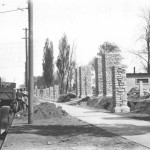By Sue Hunter Weir
A cemetery seems like an odd place to be talking about building a healthy community since it”'s where most of us will wind up when our health ultimately and inevitably fails. But cemeteries are about more than our physical selves, they are about the legacy that we leave to others and that others have given to us. They are about stories; they are about community.
Nation Builders.
Minneapolis Pioneers and Soldiers Memorial Cemetery is listed in the National Register of Historic Places. It is a place of national, not just local, significance. Part of the designation recognizes the cemetery”'s architectural features, but another part, perhaps the most important part, recognizes the role that the people who are buried here in the Phillips community played in both our local and national history. They are not people whose names are household words, yet they are recognized as nation builders.
“”¦who is worth remembering and who is not”¦?”
 Howard Mansfield (“In the Memory House”) asks important questions about which people we as a society choose to remember and which we choose to forget. Importantly, these are choices that we make. “Facts are never simply recorded; they are recorded by people for a purpose (HM).” Judgments are made about who is worth remembering and who is not.
Howard Mansfield (“In the Memory House”) asks important questions about which people we as a society choose to remember and which we choose to forget. Importantly, these are choices that we make. “Facts are never simply recorded; they are recorded by people for a purpose (HM).” Judgments are made about who is worth remembering and who is not.
To a large extent those decisions are made on the basis of artifacts, but remaining artifacts do not tell the whole story. The historical record is distorted by the fact that surviving artifacts are unrepresentative (HM).” We have saved mansions but not the homes of working class people. Everyone has a story and those stories can, and should be preserved.
So, what does this Cemetery tell us about ourselves and our shared history? For one thing, it tells us that our community has always been diverse. The cemetery”'s original owners belonged to the First Baptist Church of Minneapolis, which had close ties to the anti-slavery movement. Approximately 170 men buried in the cemetery, both African-American and white, fought to end slavery.
It tells the stories, some heartbreaking and some triumphant, of thousands of immigrants who came here to escape poverty and political oppression to build a better future for their children. Many of these immigrants were the people who worked, and all too often died, in flourmills, lumber mills and railroad yards.
It tells the story of thousands of children who died from drinking or coming into contact with contaminated water or who died because vaccinations for communicable diseases didn”'t exist.
Ordinary people doing extraordinary things.
It tells the story of ordinary people doing extraordinary things: mothers who died rescuing their children from fires and friends who died trying to save their drowning friends. It tells the story of neighbors helping neighbors in times of crisis and need.
It tells why one community and its people represent a nation.
We and our stories matter.
In the Backyard Initiative”'s 2009 Listening Circles Report, the need for a sense of community and interconnectedness and the power of relationships were recurring themes. It”'s important for us to know that we and our stories matter. We can choose who we want to remember and why and make them part of our community”'s history. Tell your stories. Write them down. Pass them on. Make your story part of our history and make our community a force to be reckoned with. It”'s the healthy thing to do.










